Ex-CDC Director Tom Frieden and New York City’s Spring 2020 Mass Casualty Event: What He and The Wall Street Journal Got Wrong
My March 2023 responses to Frieden's op-ed
On 17 March 2023, The Wall Street Journal ran Tom Frieden’s op-ed, “What Worked Against Covid: Masks, Closures and Vaccines”. Frieden, a former CDC director and New York City health commissioner, advanced many falsehoods in that piece, but the one that caught my attention concerned his figure for COVID-attributed deaths during New York City’s spring 2020 mass casualty event.
I’ve re-cast two Twitter threads I wrote in response into essay form below.1 Where my later research contradicted or refined my initial observations, I’ve added explanatory footnotes.
For context, I wrote those threads soon after publishing an article on New York City nursing-home death data, a few weeks before receiving Elmhurst Hospital’s bed-occupancy records, and two months prior to presenting my emerging hypothesis about the New York event to
.March 20, 2023 — In an essay for The Wall Street Journal, Dr. Tom Frieden has made inaccurate statements about 2020 in New York City 2020 that I am well-equipped to address. Frieden is a former CDC Director and ex-Commissioner of the New York City Department of Health and Mental Hygiene; I am a ‘student’ of the New York City COVID response.
Dr. Frieden says, “[COVID] deaths in New York City decreased from 100 a day in mid-April 2020] to 40 a day two weeks later and two a day by July 1.”
This is false.
On one hand, Frieden could be forgiven for getting this stat wrong, because data sources for NYC COVID deaths don’t agree on either the 2020 or April 2020 number of COVID deaths (figure 1).
Figure 1
On the other hand, none of these sources shows only 100 covid deaths per day for mid April.
Since Frieden is the former NYC DOH Commish, let’s look at what that agency’s data says (figure 2):
4/15/20 - 456 confirmed COVID deaths + 121 probable deaths = 577 total.
Peak for the month (and the wave) was 831.
This is much higher than Friedan's "100" claim.
Figure 2
NYC’s daily all-cause mortality shows deaths peaked at a whopping 1,200 on April 7th (figure 3). This is a city that normally sees 150-170 deaths a day, yet Tom Frieden doesn’t note or seem to grasp the scale of what occurred. Does he get it? Does The Wall Street Journal?
Figure 3
NYC's all-cause mortality began skyrocketing on March 18th. Deaths in hospital inpatient shot up first and most steeply. Over 60% of the increase occurred in hospitals, and 20% of the increase at people’s own homes (figure 4).2
Figure 4
Friedan seems clueless about any of this.
Instead, he claims that “the closure of indoor businesses and gatherings in mid-March 2020 reversed the exponential increase in cases and resulted in a rapid decline in deaths.”
It did no such thing.
There were zero signs of “silent spread” in mortality data before the city started to shut down in early March.3
“Cases” were discovered with FDA emergency use authorization for tests/testing — and with the advent of PCR testing in nursing homes/hospitals.
James Crawford from Northwell Healthcare System said during an April 6, 2020 call with the CDC that the sudden COVID focus had crowded out testing for other respiratory viruses:
"RVP testing uses up real estate on your machinery, particularly if you're using the semi-automated machines in your hospital sites. And so we have discouraged use of RVP testing in favor of COVID testing, just to ensure that we're optimizing our laboratory resources.”4
Positive tests peaked in mid-April (figure 5).
Figure 5
Only a fool would claim that deaths could’ve been worse, when all signs point to human interventions making things worse in every way.
The "rapid decline" was multi-factorial. Nursing home/other transfers into hospitals dropped. People with heart and other issues died at home. Hospitals pulled back on early intubation and other harmful practices that had been advised. Same with nursing homes same, as reports of neglect surfaced.5
Frieden also suggests that NYC hospitals were overwhelmed at some point. I don’t know what he means by “overwhelmed,” which is a feeling, not a term of quantity, or which hospitals he’s referring to.
If he means “overrun” by patient volume, no data supports that claim.6
Assuming The Wall Street Journal cares about accurate numbers and terms, an Editor should at least ask Frieden to cite his source for the NYC COVID death numbers, clarify “overwhelmed,” and name any hospitals that fit his definition.
Kelley Krohnert noticed that Frieden’s numbers seem to line up with COVID deaths “by report date” for New York County [Manhattan] only. That’s a huge, indefensible mistake if true.
In May 2020, CDC published provisional estimates of New York City’s spring 2020 all cause mortality. “NYC” is inclusive of all five boroughs (figure 6).
Tom Frieden must correct his essay.
Figure 6 - J. Hockett based on this table.
March 23, 2023 — On Tuesday [March 20, 2023], I sent two emails to The Wall Street Journal regarding Tom Frieden's New York City COVID death errors in his essay "What Worked Against Covid”: one to the editors (below) and one to the corrections staff. I also emailed Dr. Frieden's general contact address on his website.
WSJ has issued two corrections.
One is for daily NYC COVID-attributed deaths, which Dr. Frieden had greatly understated. The revised numbers don't match the @nycHealthy data I linked in my email, and no source is cited.
The other correction relates to vaccination outcomes. I don't keep up with that research/data; I'll let those who do react.
There are scads of problematic claims in Frieden’s essay that aren't revised, but at least someone reacted to feedback about numbers.
I hope The Wall Street Journal raises its standards for pandemic-related contributions.
###
All New York City articles are here. All articles specific to “epicenter of the epicenter” Elmhurst Hospital are here.
See also table below (used in various articles on Wood House 76, including this overview).
See also Hockett, J. (2022, September 19). “Where was Covid?” Wood House 76.
In other words, testing for the *new* virus was more important than testing for the typical viruses. Fewer RVP tests = Fewer detections | Transcript | Corresponding thread
Later analysis of different datasets contradicts some of these explanations. See Hockett, J. (2024, September 27). “Eleven Serious Problems with the New York City Mass Casualty Event.” Wood House 76.
Articles cited in thread: Hockett, J. (2022, November 28). NYC's hospital system never reached full capacity in spring 2020. Wood House 76. | Hockett, J. (2022, October 11). New York City ER visits plummeted in spring 2020. Wood House 76. [NOTE: Later analysis suggests that the hospital bed capacity dataset is intentionally incomplete - no baseline - and that data are “pushed” from the left. Analysis of various datasets and contemporaneous news reports for Elmhurst Hospital Center gives reasons to suspect that the ED visit drop is affected by calls being directed to telemedicine in early April 2020 or other definitional changes.]


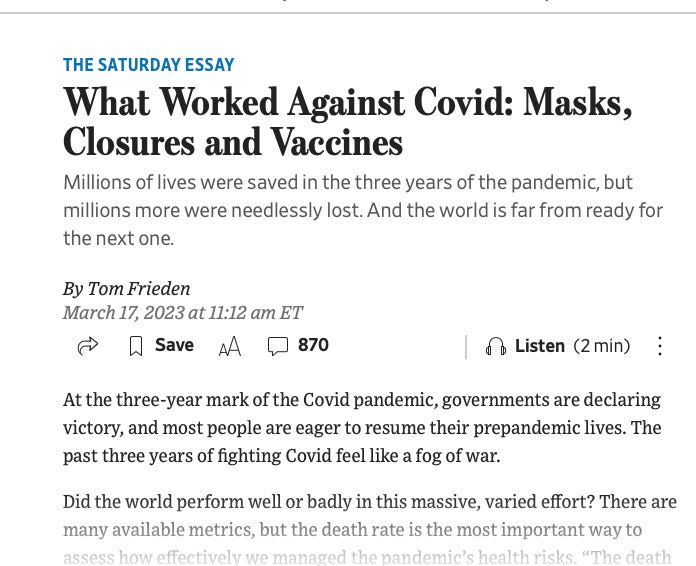
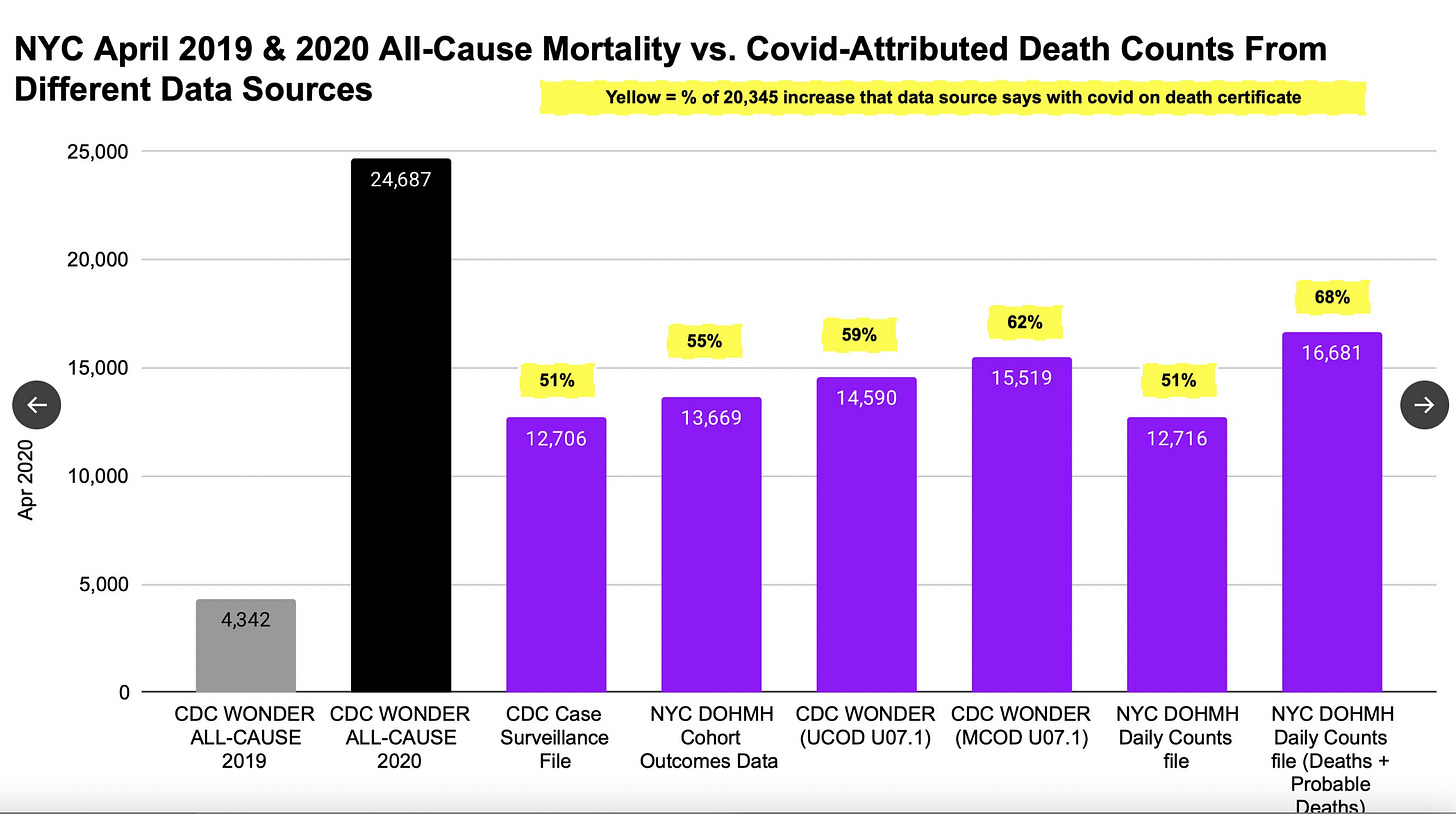
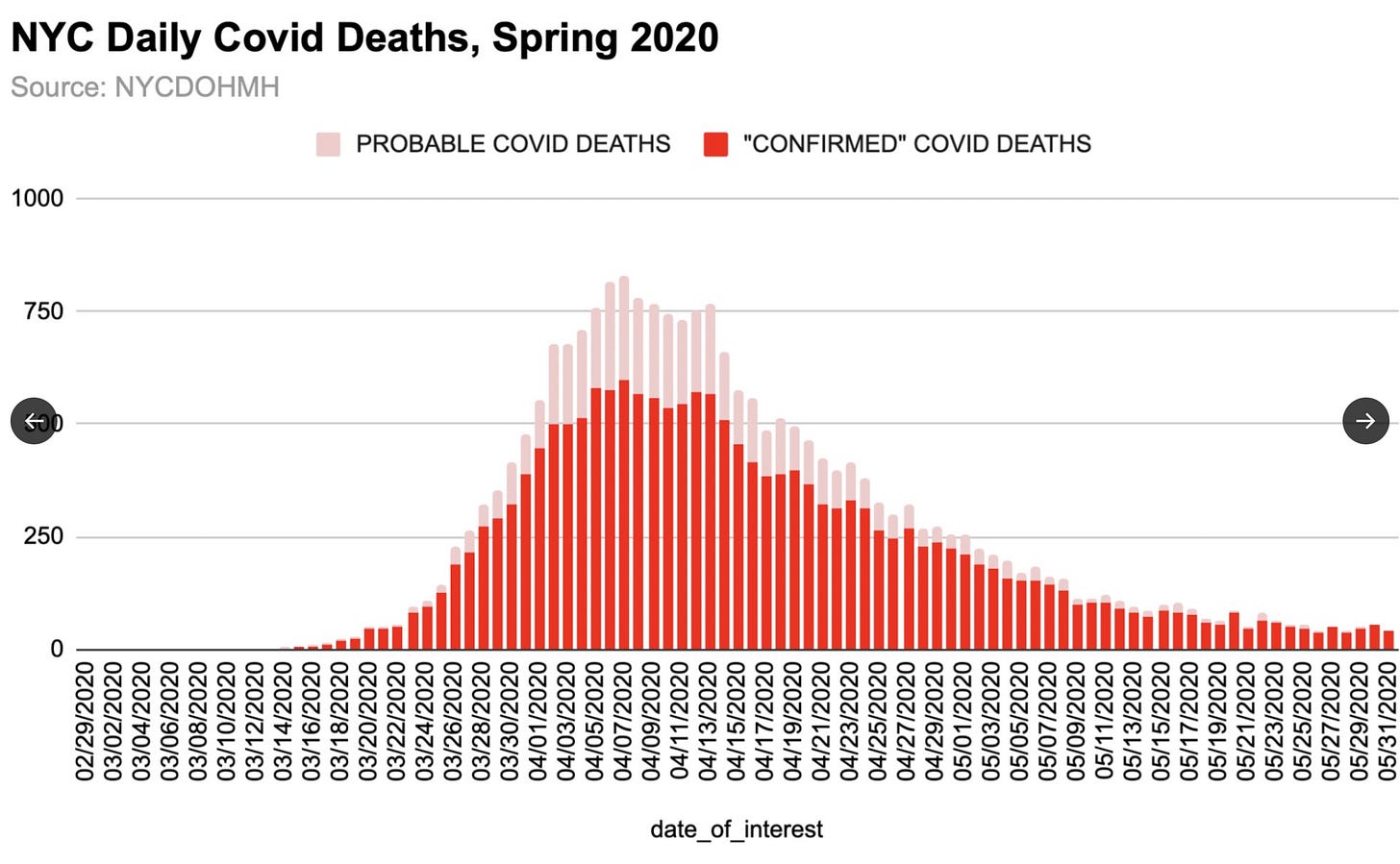
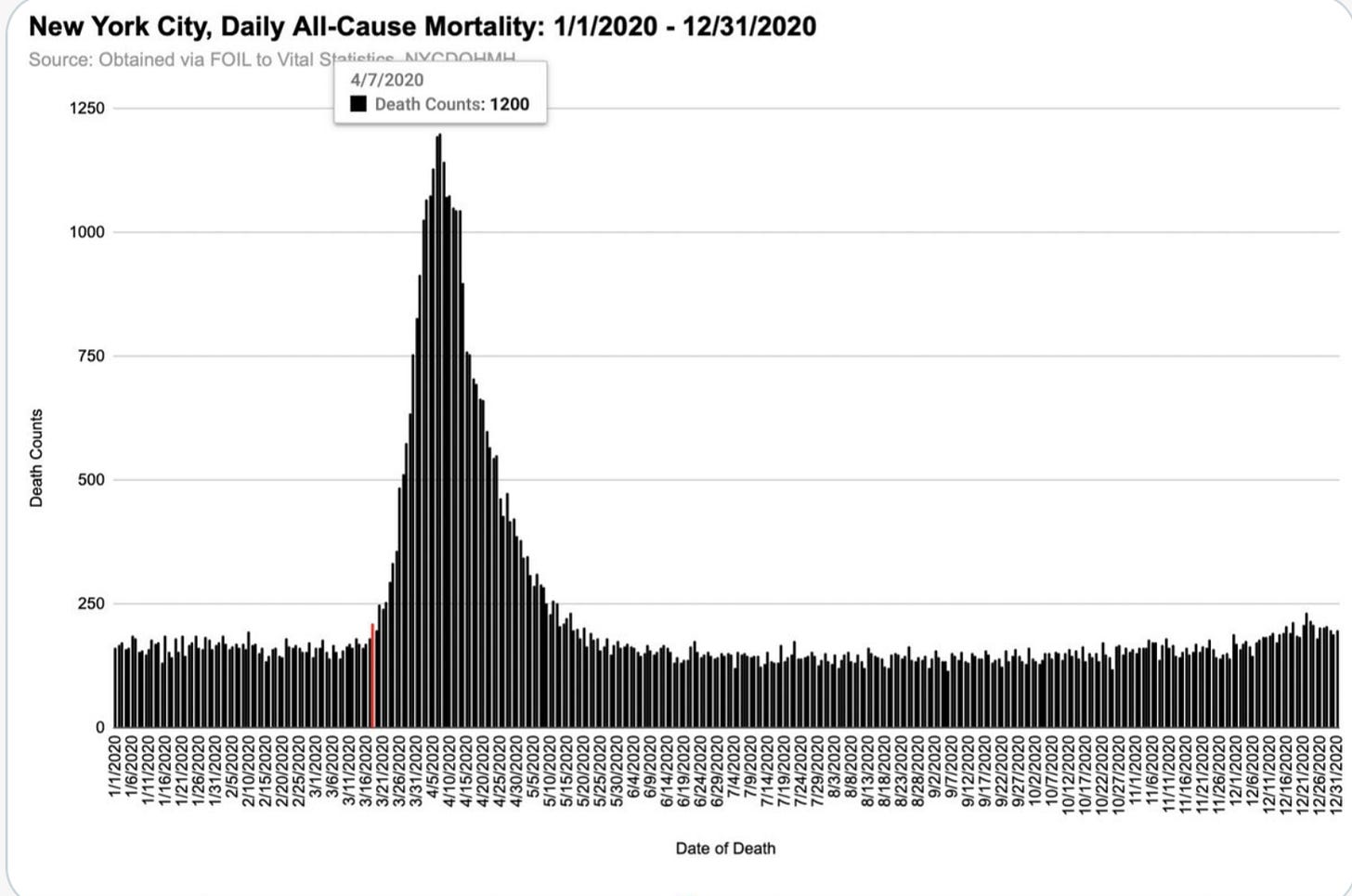
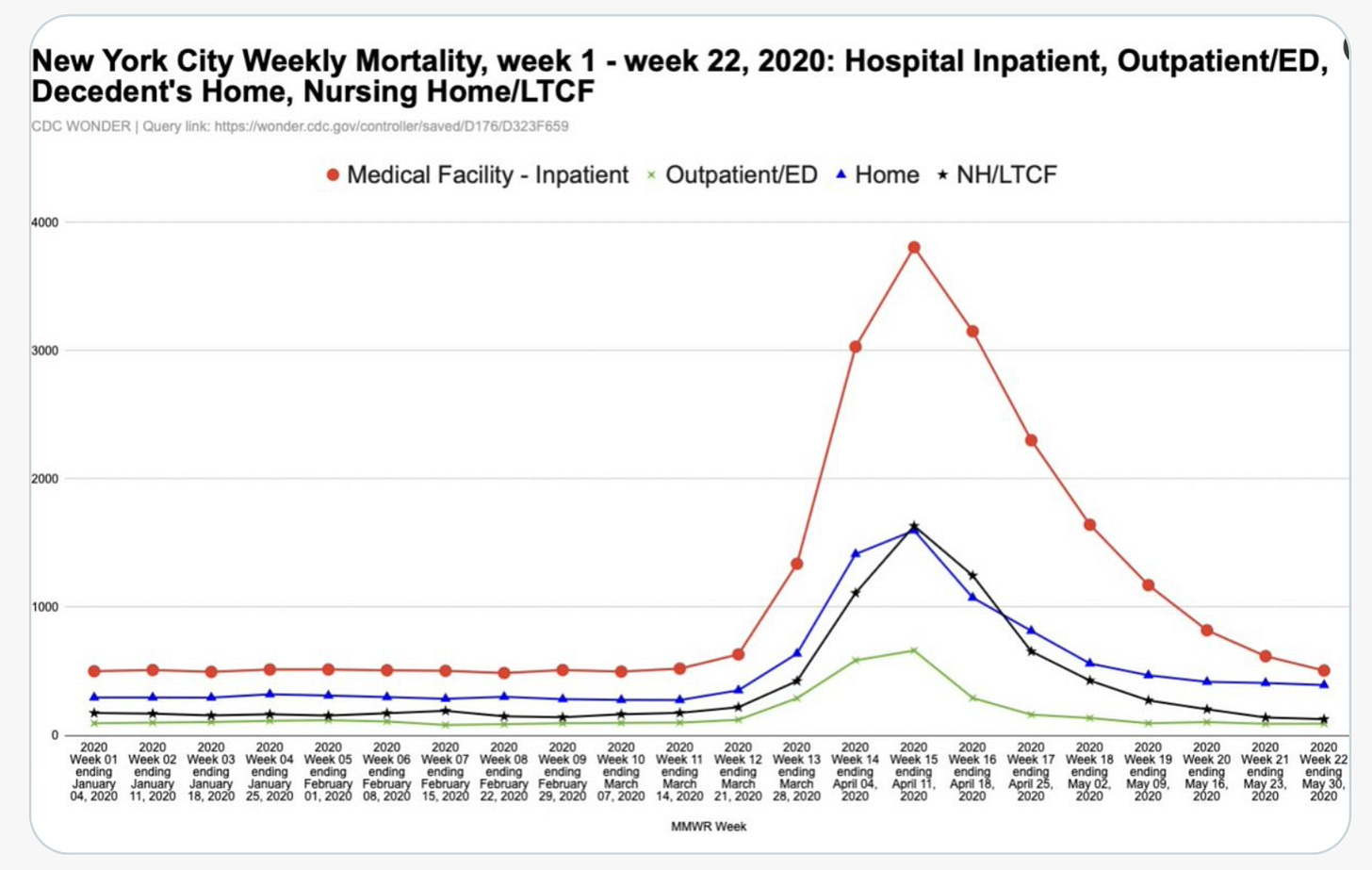

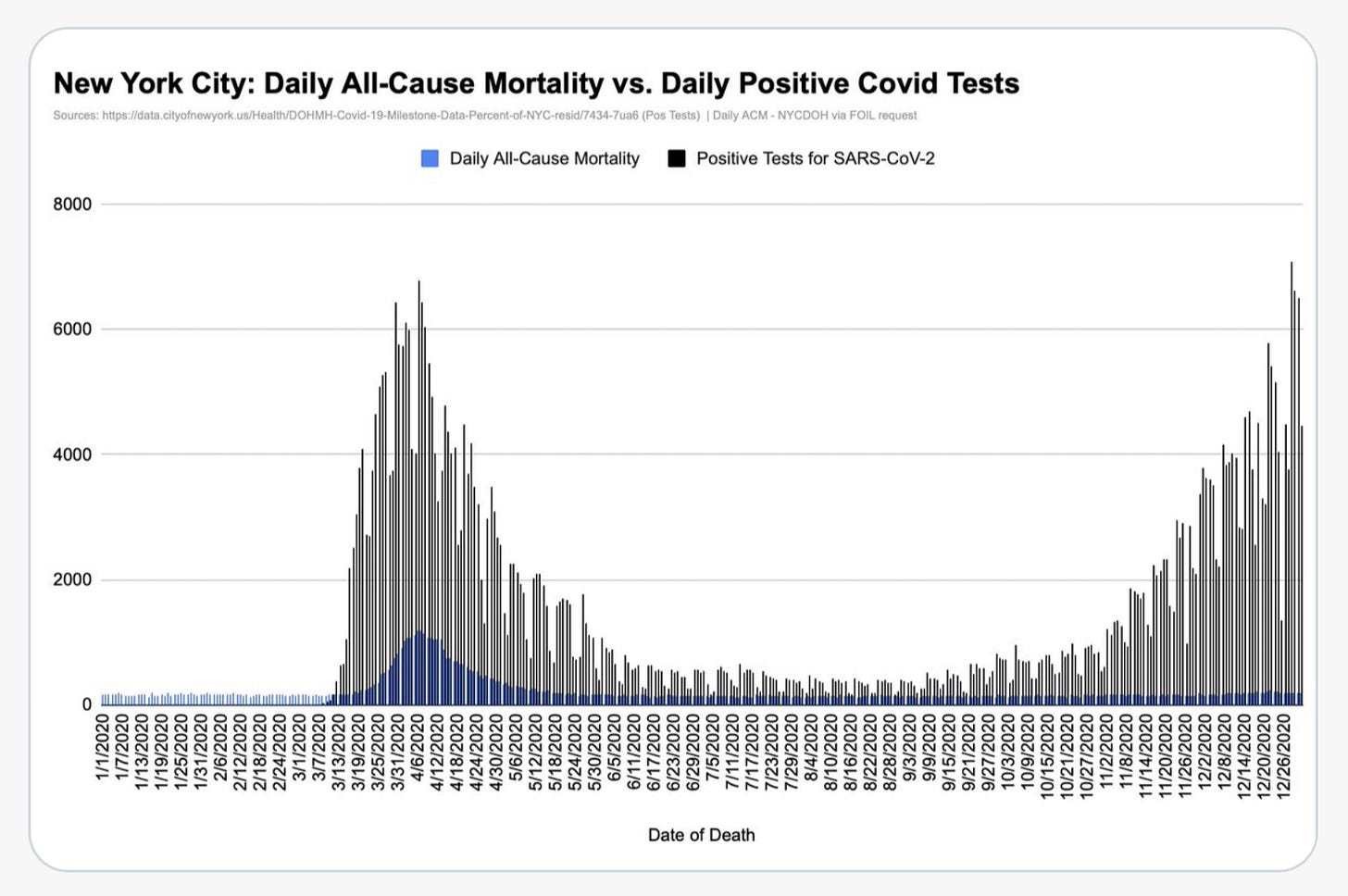

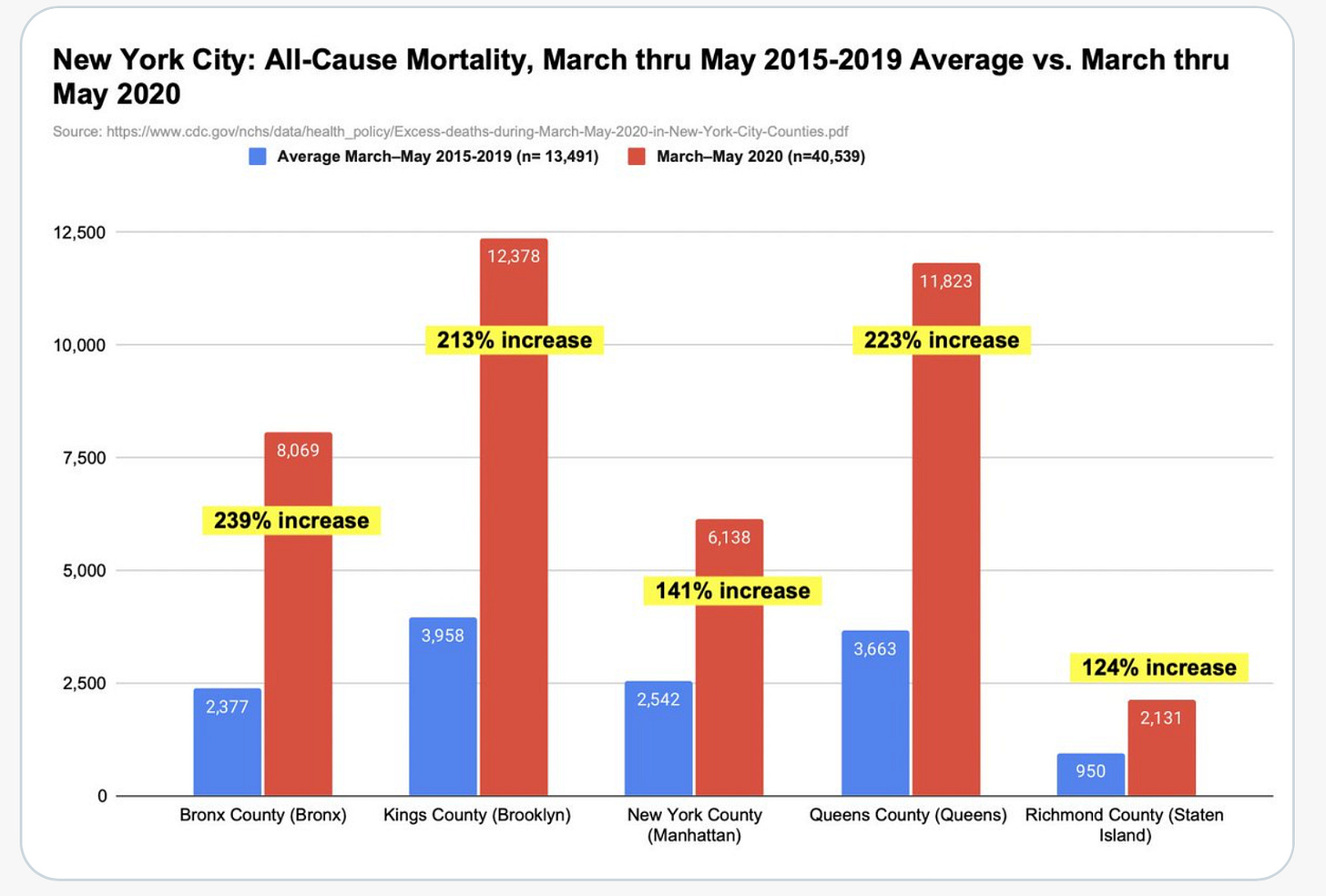

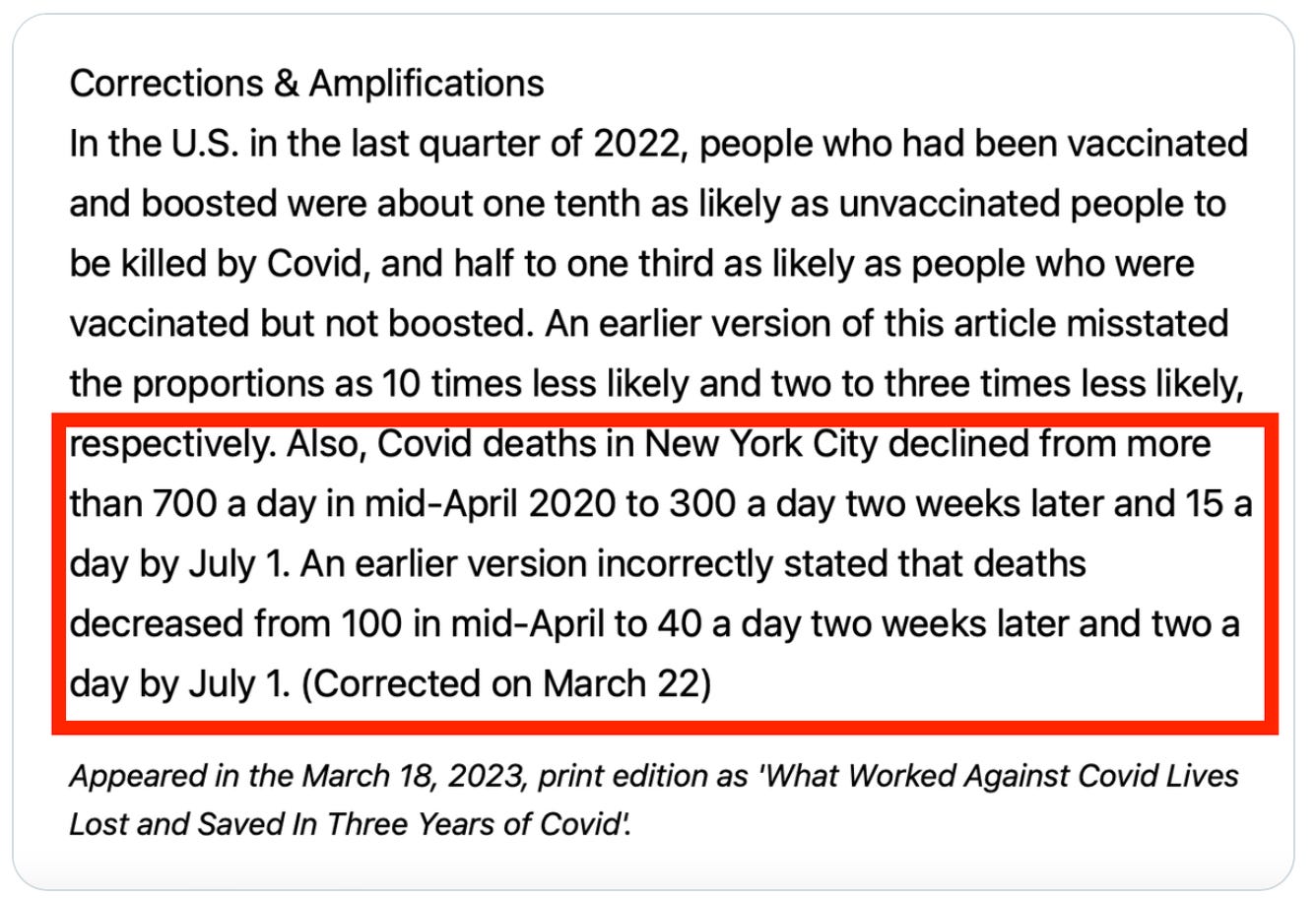
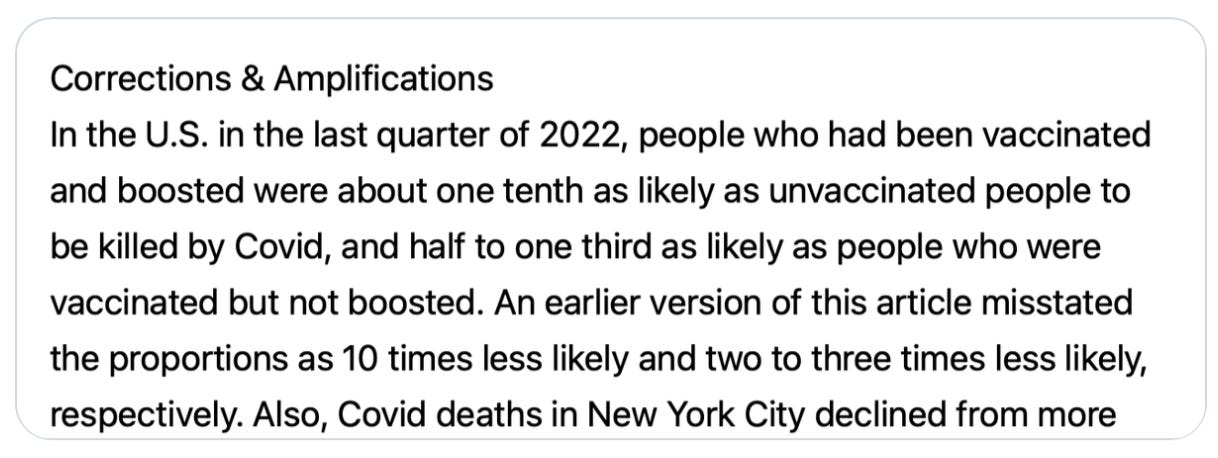
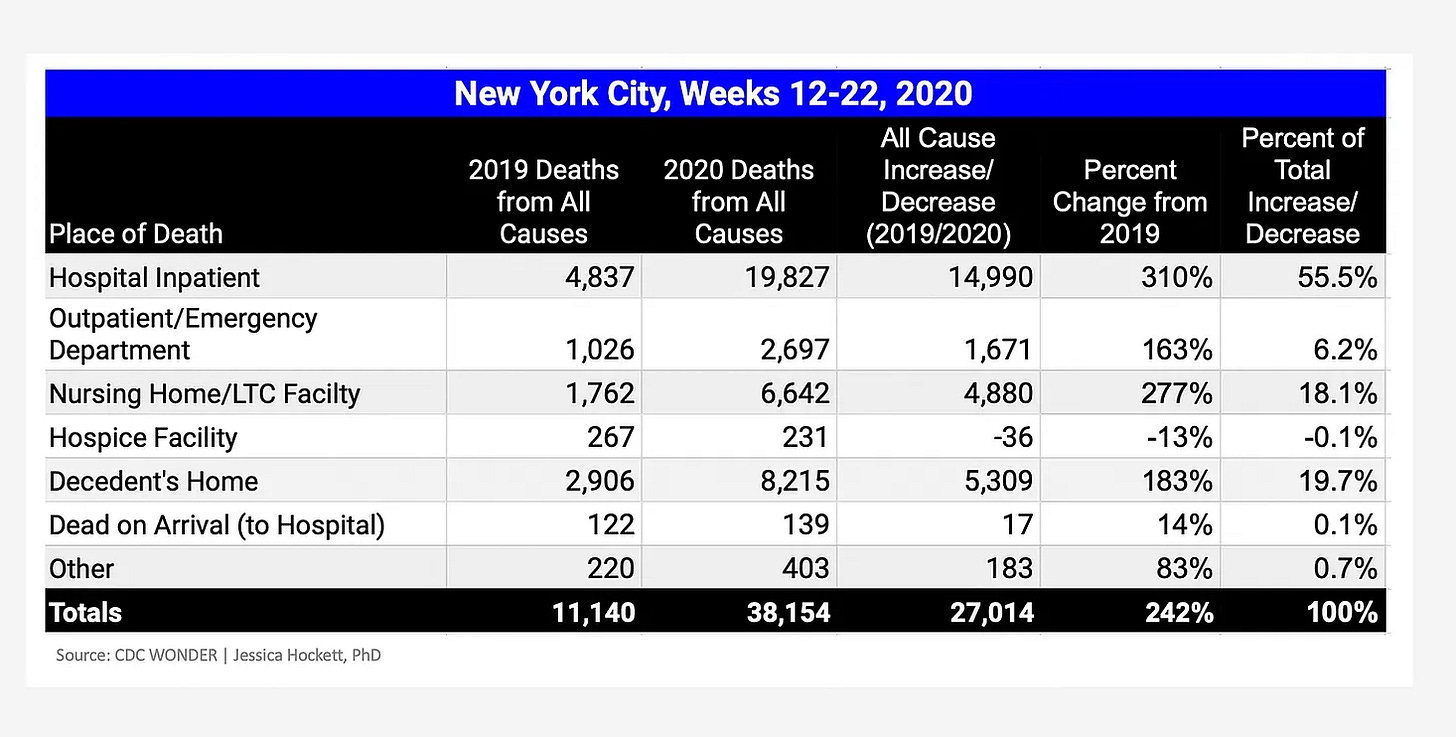
Adding (sourced) information from Wikipedia that makes TF more interesting:
During Frieden’s tenure as CDC director, he identified “winnable battles”: tobacco use, teen pregnancy, HIV, healthcare-associated infections, nutrition and physical activity, and motor vehicle fatalities. Tobacco use decreased from 21% to 15%, teen pregnancy decreased, three of four targeted healthcare-associated infections decreased, one of two targeted foodborne infections decreased, breastfeeding at six months increased, and motor vehicle fatalities decreased. There was little or no progress reducing childhood obesity, catheter-associated urinary tract infections, or foodborne illness from Salmonella.[88]
A Public Health Associate Program trained new public health specialists at state and local health departments.[89] Frieden called antimicrobial resistance “a threat to our economic stability and to modern medicine” [90] and drew attention to the overprescription of and increase in deaths from opioids[91] and oversaw a controversial CDC on prescribing practices.[92]
The guideline was criticized for resulting in excessive restrictions on opioid prescribing; critiques were at least in part the result of opioid industry influence.[93]While director, drug overdose deaths in the U.S. rose significantly—from approximately 37,000 deaths in 2009 to around 63,600 in 2016, and about 70,200 in 2017 (though Frieden resigned early that year)--during his tenure approximately 370,000 to 400,000 Americans died from drug overdoses.
https://en.wikipedia.org/wiki/Tom_Frieden
Frieden is one of the authors on this recent NYT propaganda piece: https://www.nytimes.com/2025/09/01/opinion/cdc-leaders-kennedy.html
He is far less interesting than Anne Schuchat (the real POI for me on the above) but I'm glad to have been reminded about Frieden's March 2023 WSJ piece and my analysis of it.
EDIT: the data discrepancies have never been resolved and the spring 2020 death toll (covid and non) - and event curve - is unsubstantiated.